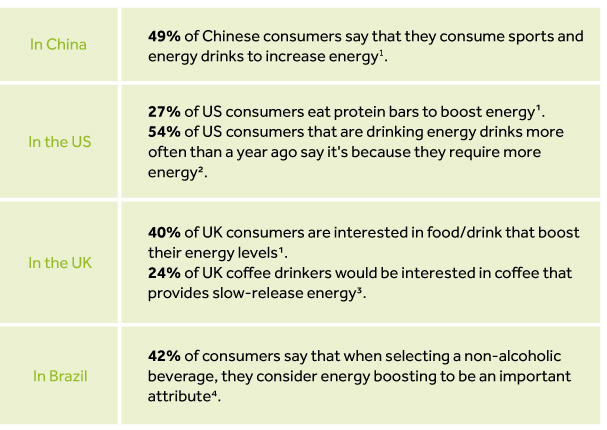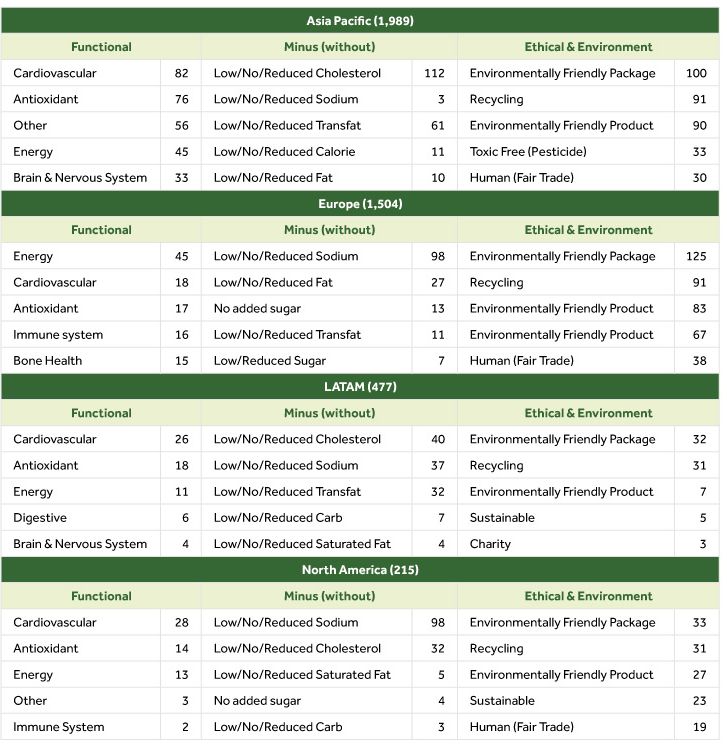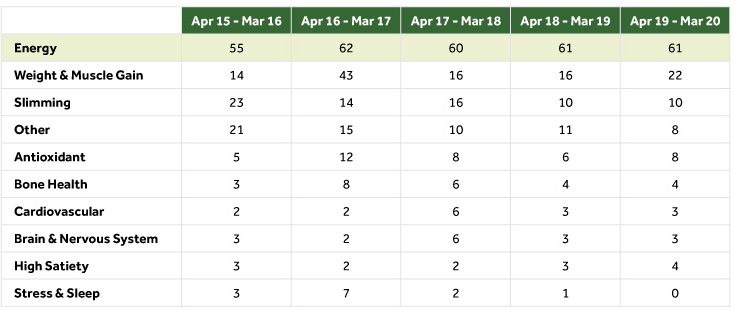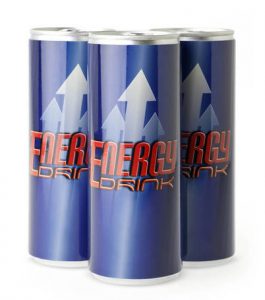2.4. Spotlight on energy boosting
INTRODUCTION
Consumers need food, drink and supplement products that help them refuel and get them through their increasingly fast-paced lives.

MARKET COMPARISON
Figure 5. Energy Boosting – Past and Future 5YR CAGR% (Compound annual growth rate)
(Bubble size: Market retail value, Mil EUR).

Table 7. Energy Boosting.

USA is by far the largest market for this category (54%), followed by China (17%) and Japan (8%). Mexico and Brazil are expected to enjoy high growth rates.
Watch out for LATAM in energy
According to Mintel1, in Latin America the number of product launches featuring an energy claim has increased 66% over the last five years –the strongest growth of any region.
This region is expected to exhibit the fastest growth of energy-boosting launches –particularly in the sports nutrition category– over the coming years due to the rise in athletic consumers.
According to Mintel Global New Products Database (GNPD), Energy was one of the most frequently used functional claims in the products that were launched in 2019 in the nut category (Table 8).
Table 8. The most frequently used claims in the nut category launched in 2019 (the numbers in the cells represent the number of products that had the claim).

‘Enhanced energy‘ is the most common health attribute in functional snack bar launches in Europe (Table 9).
Table 9. Europe: top health attributes in functional cereal, energy and snack bars NPD, 2015-20 (% of launches).

THE NEED FOR “CLEAN” ENERGY
Consumers increasingly show interest in naturally functional products which can satisfy their needs to feel energetic and healthy.
Consumers want energy-boosting products. However, they don’t want the energy at the cost of their health (no more caffeine or sugar boosts!). This may present an opportunity for nuts and dried fruits which are natural sources of energy.

ENERGY COMBINED WITH MENTAL BENEFITS AS AN OPPORTUNITY
 There is a growing acceptance about how the mind and body are closely connected. And, therefore, consumers are increasingly demanding products for both physical and mental energy, helping them to focus, deal with stress, and achieve more.
There is a growing acceptance about how the mind and body are closely connected. And, therefore, consumers are increasingly demanding products for both physical and mental energy, helping them to focus, deal with stress, and achieve more.
According to Mintel5, products combining these two benefits can achieve a competitive advantage in offering wellbeing and performance at the same time.
The days of dependence on high caffeine or energy drinks to stay awake for long hours then experiencing a sugar crash are gone.
Now, consumers want to maximize today’s energy while still maintaining focus.
According to Mintel, in the last five years, energy-boosting food, drink and healthcare launches carrying brain & nervous system claims increased by 25%.
The sports nutrition and energy drinks sector, in particular, increasingly leverage this dual-benefit approach.
PROTEIN AS AN OPPORTUNITY TERRITORY FOR SLOW ENERGY
 Sugar is commonly used on energy boosting products since it is released quickly from the digestive system to the body.
Sugar is commonly used on energy boosting products since it is released quickly from the digestive system to the body.
However, consumers want prolonged energy over time. With this in mind, offering nuts as a source of protein based ‘slow energy‘ without the “crash” could present an opportunity.
Protein is also related to muscle building and it is slowly digested. It can help lower the absorption of carbohydrates and prevent blood sugar from spiking or crashing.
Energy that lasts, 47% of US consumers are motivated to purchase an energy drink that offers long-lasting energy6.
REFERENCES
- A new approach to energy-boosting product formulations, Mintel, February 2020.
- Energy Drinks, Mintel, US, 2019.
- Coffee, Mintel, UK, 2019.
- Beverage Blurring – Consumer needs and how they can influence the industry – Brazil, January 2019, Mintel.
- Mintel Global New Products Database (GNPD), 2020.
- The American Journal of Clinical Nutrition; Lightspeed/Mintel. Base: 535 internet users aged 18+ who have consumed any energy drink in the past three months.




